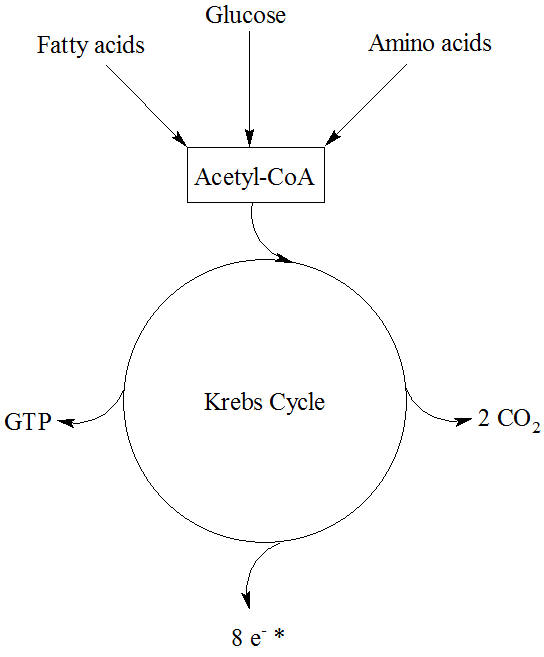Krebs cycle importance
From Proteopedia
The importance of the Krebs Cycle in the metabolism
The Krebs cycle is the second of three stages of cellular respiration, in which glucose, fatty acids and certain amino acids, the so-called fuel molecules, are oxidized (see Figure). The oxidation of these molecules is primarily used to transform the energy contained in these molecules into ATP. ATP provides for example energy for muscle contractions and can therefore be referred to as "energy currency" of the cells.
Before the fuel molecules can be inserted in the Krebs Cycle, they must first all be converted into acetyl-CoA. Looking at the path of a nutrient, such as glucose, the oxidation of the molecule takes place in the glycolysis. The product of the glycolysis is pyruvate. In a further reaction, which is catalyzed by the enzyme complex pyruvate dehydrogenase, acetyl-CoA is formed out of pyruvate, which can be introduced into the citric acid cycle or Krebs Cycle.
In an eight-step reaction sequence, the acetyl group of acetyl-CoA is oxidised into two molecules of CO2 (see Figure). These reactions are catalysed by eight different enzymes. Instead of producing high amounts of ATP, eight electrons were removed from the acetyl group and transferred to the coenzymes NAD+ and FAD, which are reduced to NADH and FADH2. They are therefore called electron carrier coenzymes and are used to transport electrons from the Krebs cycle to the respiratory chain. Through a series of molecules, the reduced coenzymes NADH and FADH2 are oxidised and the released electrons were used to reduce O2. Finally, the electrons that are released in the Krebs Cycle and the transported to the respiratory chain were used there to produce ATP out of ADP and Pi.
Figure: Overview of the Krebs cycle
In addition to the supply of energy from the fuel molecules, the citric acid cycle has other important functions. Thus, some of the citric acid cycle are intermediates for other important reactions like the biosynthesis of glucose, fatty acids and amino acids.
Due to the many functions of the citric acid cycle is also considered to be the "central hub of metabolism". This is because, as most of the absorbed nutrients, the fuel molecules are oxidized ultimately within the Krebs Cycke and its intermediates are used for various biosynthetic pathways. Figuratively, one can look at the citric acid cycle as a " roundabout" introduce, in which the nutrients (carbohydrates, fatty acids and amino acids) "drive in" and "drive out " again at the different locations for the synthesis of other substances.
- Major metabolic pathways converging on the citric acid cycle
- Citric acid cycle intermediates serve as substrates for biosynthetic processes
- Gluconeogenesis
- Cori cycle
- Glyoxylate cycle

